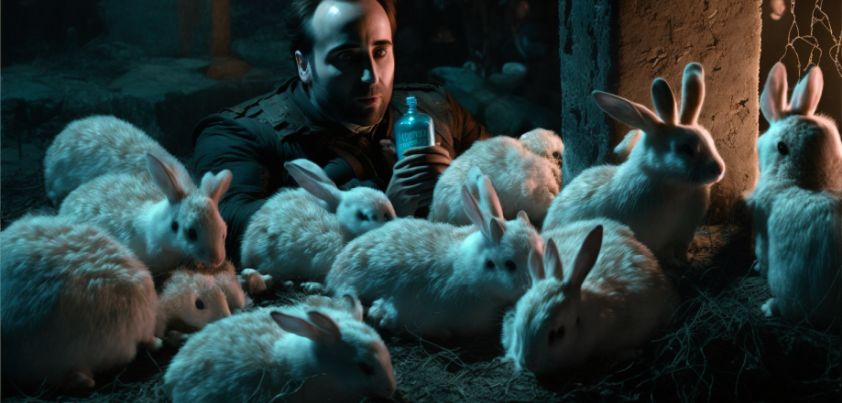 This story is said to be Julio Cortázar’s first attempt at realism. Although the subject of the story (prodigious jazz musician Johnny Parker) is fictional, the events closely follow the personal life and last months of jazz legend Charlie Parker. Told through the eyes of Johnny’s close friend and biographer, the story not only pays tribute Parker’s extraordinary talent, but also lays bare the demons (mental health problems, heroin addiction, and alcohol abuse) that led to his death at thirty-four. Themes include friendship, mental illness, substance abuse, pursuit in art and life, the nature of time and reality. More…
This story is said to be Julio Cortázar’s first attempt at realism. Although the subject of the story (prodigious jazz musician Johnny Parker) is fictional, the events closely follow the personal life and last months of jazz legend Charlie Parker. Told through the eyes of Johnny’s close friend and biographer, the story not only pays tribute Parker’s extraordinary talent, but also lays bare the demons (mental health problems, heroin addiction, and alcohol abuse) that led to his death at thirty-four. Themes include friendship, mental illness, substance abuse, pursuit in art and life, the nature of time and reality. More…
Archives
House Taken Over
 Said to be Julio Cortázar’s first published story, this suspenseful tale is about a middle-aged brother and sister who, having never married, live quiet but contented lives in their aging family mansion. One night, their solitude is interrupted by strange noises coming from a disused wing of the house. The brother locks and bolts the door leading to that part of the house. Unfortunately, the title foreshadows the final outcome. The brother and sister know the identity of the intruders (referred to only as “they”), but this is not shared with the reader. Themes: the idle rich, isolation, fear, change. More…
Said to be Julio Cortázar’s first published story, this suspenseful tale is about a middle-aged brother and sister who, having never married, live quiet but contented lives in their aging family mansion. One night, their solitude is interrupted by strange noises coming from a disused wing of the house. The brother locks and bolts the door leading to that part of the house. Unfortunately, the title foreshadows the final outcome. The brother and sister know the identity of the intruders (referred to only as “they”), but this is not shared with the reader. Themes: the idle rich, isolation, fear, change. More…
The Continuity of Parks
 Julio Cortázar‘s The Continuity of Parks is unusual in that it is a “story within a story” in which the two stories come together. The title stems from the fact that part of the setting of both stories is the same park at the same time. A tired businessman relaxes with a book. He becomes absorbed in the story (a murder mystery), unaware that the “hero” and “heroine” featured in the book are nearby preparing for the murder he is reading about, and that he is the intended victim! Themes include escape, betrayal, murder, the continuity between fiction and reality. More…
Julio Cortázar‘s The Continuity of Parks is unusual in that it is a “story within a story” in which the two stories come together. The title stems from the fact that part of the setting of both stories is the same park at the same time. A tired businessman relaxes with a book. He becomes absorbed in the story (a murder mystery), unaware that the “hero” and “heroine” featured in the book are nearby preparing for the murder he is reading about, and that he is the intended victim! Themes include escape, betrayal, murder, the continuity between fiction and reality. More…
The Night Face Up
 In this story by Julio Cortázar, a man hospitalized after a motorcycle accident drifts in and out between the “present” and a “dream” in which he is a member of an ancient tribe being hunted by Aztec warriors for sacrifice. As he struggles to stay awake in his hospital ward, his dream-self is captured, imprisoned, and carried up the temple steps for execution. At the moment of death, he recalls a dream about riding through an astonishing city on an enormous metal insect that whirred away between his legs. Themes include time and space (parallel worlds), existence, dreams vs. reality. More…
In this story by Julio Cortázar, a man hospitalized after a motorcycle accident drifts in and out between the “present” and a “dream” in which he is a member of an ancient tribe being hunted by Aztec warriors for sacrifice. As he struggles to stay awake in his hospital ward, his dream-self is captured, imprisoned, and carried up the temple steps for execution. At the moment of death, he recalls a dream about riding through an astonishing city on an enormous metal insect that whirred away between his legs. Themes include time and space (parallel worlds), existence, dreams vs. reality. More…
Axolotl
 Julio Cortázar gives away the plot of this story in the first paragraph: There was a time when I thought a great deal about the axolotls… Now I am an axolotl. The rest of the story talks about this Kafkaesque transformation, which is partial and may have only occurred in the protagonist’s mind. He (the axolotl part) sits in an aquarium tank watching himself (the unchanged part) looking in from the other side. Considering his life from this perspective seemingly builds the man’s self-esteem, and he no longer feels the need to return. Themes: loneliness, alienation, obsession, connection, enlightenment, inertia. More…
Julio Cortázar gives away the plot of this story in the first paragraph: There was a time when I thought a great deal about the axolotls… Now I am an axolotl. The rest of the story talks about this Kafkaesque transformation, which is partial and may have only occurred in the protagonist’s mind. He (the axolotl part) sits in an aquarium tank watching himself (the unchanged part) looking in from the other side. Considering his life from this perspective seemingly builds the man’s self-esteem, and he no longer feels the need to return. Themes: loneliness, alienation, obsession, connection, enlightenment, inertia. More…
Blow-Up
 After a commentary on the role of perspective and the art of storytelling, this Julio Cortázar story goes on to describe how an amateur photographer captures an image that seemingly comes alive, rewriting its narrative. While taking the photograph (of an adolescent boy in an obviously uncomfortable discussion with an adult woman) he comes up with several possible interpretations of what is taking place and what may happen afterwards. Things take a dark turn when he realizes that a man in a nearby car is part of the narrative. Themes include storytelling, narrative perspective, speculation, obsession, artistic imagery vs. reality. More…
After a commentary on the role of perspective and the art of storytelling, this Julio Cortázar story goes on to describe how an amateur photographer captures an image that seemingly comes alive, rewriting its narrative. While taking the photograph (of an adolescent boy in an obviously uncomfortable discussion with an adult woman) he comes up with several possible interpretations of what is taking place and what may happen afterwards. Things take a dark turn when he realizes that a man in a nearby car is part of the narrative. Themes include storytelling, narrative perspective, speculation, obsession, artistic imagery vs. reality. More…
End of the Game
 This Julio Cortázar story involves two “games”. One is the daily Statues role-play three adolescent girls perform to entertain passengers on a passing train. The second is also a game of pretend… ignoring the effect a debilitating disability will have on one of their lives. For the disabled girl (Letitia), Statues is the only physical activity in which she can match the others. They in turn are resentful of Letitia’s special treatment at home. When a boy on the train takes a special interest in Letitia, both games end. Themes: fantasy vs. reality, envy, guilt, confronting disability, coming of age. More…
This Julio Cortázar story involves two “games”. One is the daily Statues role-play three adolescent girls perform to entertain passengers on a passing train. The second is also a game of pretend… ignoring the effect a debilitating disability will have on one of their lives. For the disabled girl (Letitia), Statues is the only physical activity in which she can match the others. They in turn are resentful of Letitia’s special treatment at home. When a boy on the train takes a special interest in Letitia, both games end. Themes: fantasy vs. reality, envy, guilt, confronting disability, coming of age. More…
Letter to a Young Lady in Paris
 This surreal story by Julio Cortázar is in the form of a letter from an Argentinean man to a friend who has allowed him to stay in her apartment while she is visiting Paris. His concerns about disrupting the compact order of her rooms become a reality when, on the point of moving in, he vomits up a tiny rabbit. This is normally an occasional occurrence, but ten more bunnies pop out over the following weeks. As they grow and begin to trash the place, he contemplates drastic action. Themes include phobia (about moving), obsession (with orderliness), depression, alienation, despair. More…
This surreal story by Julio Cortázar is in the form of a letter from an Argentinean man to a friend who has allowed him to stay in her apartment while she is visiting Paris. His concerns about disrupting the compact order of her rooms become a reality when, on the point of moving in, he vomits up a tiny rabbit. This is normally an occasional occurrence, but ten more bunnies pop out over the following weeks. As they grow and begin to trash the place, he contemplates drastic action. Themes include phobia (about moving), obsession (with orderliness), depression, alienation, despair. More…